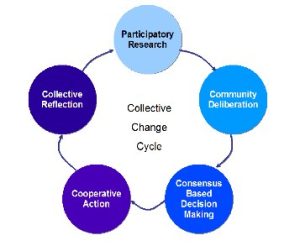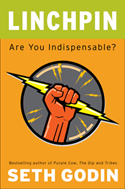 Good question. I first heard about liminal space from Patti Digh and David Robinson of The Circle Project. Among other things, they work with corporate America to surface and tackle racism. Now if there’s one difficult subject for behaviour change, then racism has to be up there. They describe the work they do as “helping individuals, organizations, and communities create new patterns, new stories, new cultures.” Sounds like it could be another way of describing behaviour change.
Good question. I first heard about liminal space from Patti Digh and David Robinson of The Circle Project. Among other things, they work with corporate America to surface and tackle racism. Now if there’s one difficult subject for behaviour change, then racism has to be up there. They describe the work they do as “helping individuals, organizations, and communities create new patterns, new stories, new cultures.” Sounds like it could be another way of describing behaviour change.
So maybe there’ something useful in understanding liminality – or maybe not? You be the judge.
Liminal space is described (rather unhelpfully, I think) as the ‘space between’.
If you want to do some research yourself on this topic here’s a few options.
The Journal of International Political Anthropology, July 2009, (and you thought I was just a facilitator) is completely devoted to liminality. In the introduction, Liminality and Cultures of Change, the editors write “This issue is concerned with the concept of liminality, a major concept in cultural and social anthropology whose importance for the understanding of wider processes of social and political change has been understudied so far.”
And then there’s this article written by Charles La Shure titled ‘What is Liminality’.
Here’s the crux of what I understand about liminality and why it’s important to behaviour change (caveat – these are my own thoughts). If we’re serious about changing the way people act we have to consider that people act a certain way because of habit. I can only speak for myself, but I know that more information will not do the trick. In fact, Seth Godin wrote about a similar thing recently (albeit in relation to marketing). Here’s what he wrote about Too much data leads to not enough belief:
“Business plans with too much detail, books with too much proof, politicians with too much granularity… it seems as though more data is a good thing, because data proves the case.
In my experience, data crowds out faith. And without faith, it’s hard to believe in the data enough to make a leap. Big mergers, big VC investments, big political movements, large congregations… they don’t usually turn out for a spreadsheet.
The problem is this: no spreadsheet, no bibliography and no list of resources is sufficient proof to someone who chooses not to believe. The skeptic will always find a reason, even if it’s one the rest of us don’t think is a good one. Relying too much on proof distracts you from the real mission–which is emotional connection.”
Now I don’t profess to know what to replace yet more information with – although I do know that building relationships and emotional connection is part of the answer – but I do know that if I’m going to change my behaviour, be it in relation to the environment, health, safety or whatever, I have to first LET GO of what I’m currently doing. That can be hard. Even in the face of overwhelming evidence, my habits are, well, MY habits. I own them. They are a part of who I am. They are a part of my character. They make me feel safe (if not be safe), and they are predictable.
When you’re asking me to change a particular behaviour (even if it’s for my own good, or for the well-being of others, or even the planet) you’re asking me to let go of something familiar and take up something unfamilar. That space between letting go and grabbing on to something new is called liminal space. You’re asking me to enter a space of unknowing, of uncertaintly and of change. Is it any wonder I’m reluctant?
I’m more likely to enter liminal space if I think it’s OK, if I feel safe, and have some idea of what I’ll be grabbing onto. Think of it this way. If you were a trapeze artist, would you let go of the bar if there was no safety net and no-one on the other trapeze to catch you? Or if the trapeze is a bit of a stretch for you, think of monkey bars at the playground. Spend some time watching kids playing on them. There you can see liminal space in action. It’s not possible to make any progress on monkey bars unless you let go of one bar before grabbing hold of the next one. In fact, that’s probably an even better analogy for behavior change, because on the monkey bars, you usually hedge your bets – holding on to the previous bar with one hand while grabbing the next one with the other. Sooner or later though you STILL have to LET GO to progress.
So in our behaviour change programs, what are we asking people to let go of and how are we supporting them in liminal space?
Cheers, Viv



 Good question. I first heard about liminal space from
Good question. I first heard about liminal space from 